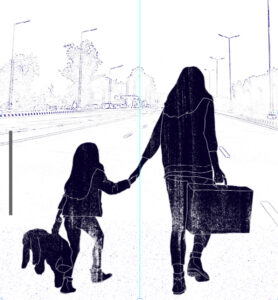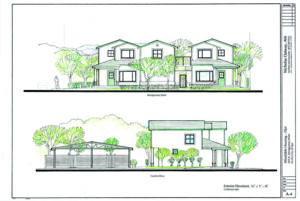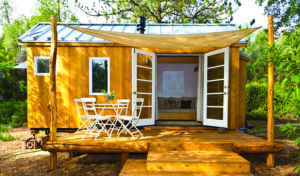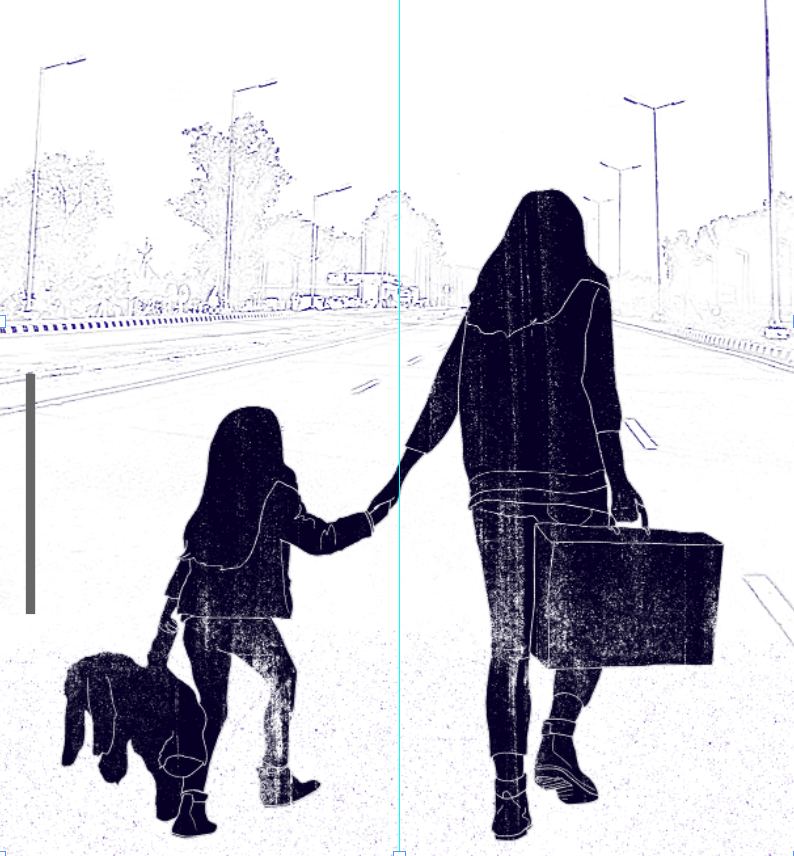FEATURES | By Michelaina Johnson
The Cost of Home

Ojai’s affordable housing gap
The lack of affordable housing in Ojai affects everyone. The impacts are especially felt by people who help create and protect Ojai’s quality of life: teachers, police and service-industry workers who daily commute from Oxnard or Ventura.
“It can be hard to find affordable housing in Ojai because of the price, especially for a single mom like me. After I divorced, I searched for a place but was rejected because I have a kid. They accept animals but don’t allow kids,” said Dilsye Torres, who is in her mid-20s and works full-time in customer service. She shares a room in a house and has taken a second job, necessities made more difficult because her daughter is not in school due to the COVID-19 pandemic.
“I live with a family now because, being a single mom, it’s easier to be closer to work, school, and home. If my car breaks down, I don’t always have the extra money to repair it. And I can’t work more than I already do because I need to spend time with my daughter. It’d be more expensive to get a nanny than to get a second job.”
Her experience is not uncommon for low- and middle-income earners in the Ojai Valley, many of whom struggle to afford their housing month to month, let alone save for the future. In fact, the City of Ojai’s 2014-2021 Housing Element, a component of the General Plan that analyzes the housing needs of the 7,470 people who reside in Ojai’s approximately four square miles, lists single mothers as one of the vulnerable groups that “have traditionally experienced a more difficult time finding decent, affordable housing.”
The Housing Element reports about 11 percent of owner-occupied households and 18 percent of rentals within the city limits are headed by women. “While female-headed households represent a relatively small portion of all households, they often have special challenges of balancing work and childcare responsibilities. All of the City’s efforts to increase the supply of affordable housing respond to the needs of female-headed households,” the report reads.
Other vulnerable groups include people with disabilities, farmworkers, the elderly and homeless people. The number of renter and owner-occupied households within the city limits that accommodate elderly (65+ years), five or more people and are headed by females — those vulnerable groups — totaled around 53 percent of all Ojai households in 2013. Meanwhile, the City is also home to at least 956 people who are either homeless, under 65 years of age with a disability or are farmworkers, according to the Housing Element and U.S. Census.
The totals here are minimum estimates because, due to the City of Ojai’s small size, data on certain vulnerable groups are not tallied in the American Community Survey or available in other sources. In fact, the numbers for these vulnerable groups are higher when you take into account people living in the approximately 30 square miles of the Ojai Valley.
 The dream of owning a home is financially out of reach for all but a few local workers. The average individual in the City of Ojai made $43,529 and the median household netted $70,403 in 2018, according to Census data.
The dream of owning a home is financially out of reach for all but a few local workers. The average individual in the City of Ojai made $43,529 and the median household netted $70,403 in 2018, according to Census data.
“People with that average combined income per census data in Ventura County would not be able to afford the average-priced home in Ojai,” said local realtor Erik Wilde. He added that, on the low end, a three-bedroom home in the Valley now sells for about $600,000, with no options under that except for mobile homes and a few condominiums.
Rents are high for locals, said Riddell. He estimated a fair rental price for a 2-bedroom, 1-bathroom home in the Ojai Valley is $2,350 and around $2,000 for a 2-bedroom, 1-bathroom apartment. For a working family or individual, this amount going out monthly makes saving for a down payment, paying rent and decreasing their debt monumental feats.
“When the income levels of the low-income people do not keep pace with a minimum wage, nothing is affordable,” said Ojai Mayor Johnny Johnston, who has worked in development since 1985. “We are not going to solve the problem without a living wage and without rent stabilization.” In 2018, 8.5 percent of city residents lived in poverty, according to the U.S. Census. That figure is likely to rise.
As of December 2013, 45 percent of all Ojai occupants rented while 55 percent owned their homes. Overpayment can lead to deteriorating houses, require families to double up in dwellings, overcrowding and related problems.
One part of the problem is the Ojai Valley lacks the high-paying jobs that nearby Thousand Oaks, Ventura and Oxnard offer. Businesses have left the area because it lacks the infrastructure, workforce and supply storage to manage their operations.
For these reasons, City Councilman Ryan Blatz said numerous Ojai residents have to commute out-of-town for work, which then contributes to air pollution, traffic and money circulating outside the local economy. The Air Quality Index numbers show Ojai is higher in particulate matter than the state of California and the nation. More affordable housing throughout the Ojai Valley would benefit families, especially the many living at or below the poverty line, and reduce carbon emissions and traffic. But how do we get it done?
Building More Affordable Housing
 The city has to demonstrate in the Housing Element that it has enough land available for developers to generate 371 units, the number of homes estimated for Ojai to keep pace with population growth between 2014-2021. This number was determined through a process called the Regional Housing Needs Assessment (RHNA), which takes input from regional leaders that make up the Southern California Association of Governments (SCAG). Mayor Johnston said the RHNA number is in the process of being reevaluated and reduced significantly because SCAG recognizes that Ojai lacks the transportation infrastructure, open land and jobs to support such an upsurge in people.
The city has to demonstrate in the Housing Element that it has enough land available for developers to generate 371 units, the number of homes estimated for Ojai to keep pace with population growth between 2014-2021. This number was determined through a process called the Regional Housing Needs Assessment (RHNA), which takes input from regional leaders that make up the Southern California Association of Governments (SCAG). Mayor Johnston said the RHNA number is in the process of being reevaluated and reduced significantly because SCAG recognizes that Ojai lacks the transportation infrastructure, open land and jobs to support such an upsurge in people.
According to Blatz, even though the City has complied with all state rules regarding housing, those units aren’t in the process of being built. Certainly not all 371 of them.
The state of California in the past few years has taken steps to ameliorate the housing crisis. Though local political leaders recognize the need for change, many experts are concerned that, if the recently passed legislation is strictly enforced, they could have dire consequences for the County of Ventura and City of Ojai. Proposed Senate Bill 102, for instance, would punish cities and counties for not meeting their housing goals with fines that could range from $10,000 to $600,000 per month. In addition, Senate Bill 35 streamlined the process for approving affordable housing projects, but some Ojai officials worry the enforcement of this bill could limit the city’s ability to govern itself.
After the Blaze
The Thomas Fire, which burned dozens of homes in the unincorporated parts of the Valley, including Upper Ojai, exacerbated the already-stressed housing situation. Riddell saw rental prices and demand increase after the fire, and displaced residents of Ventura and Santa Barbara counties are still calling him for rental openings.
As the founder of the Greater Goods’ Disaster Relief Fund, Vaughn Montgomery heard dozens of stories from Thomas Fire victims, from which he concluded that numerous people were unable to rebuild because they lacked fire insurance or capital, their landlord didn’t want to rebuild or the dwelling was technically illegal.
Data collected by realtors in the Ojai Valley showed that the average price of a single-family home sold between Upper Ojai and Oak View was $1,020,717 in 2019. Wilde points out that because there are so few homes sold annually in the Ojai region (252 single family homes in 2019), the “average” sale price is skewed because of the small sample size. When the top four highest sales are taken away, the average price of single family homes sold dropped to $911,475. However, the average value does not necessarily reflect the sale price of a home, which can be exorbitantly more, said Wilde.
On March 20th, the day after Governor Gavin Newsom announced the shelter-in-place order, Jonathan Riddell, a local realtor who specialized in rentals, received 30 calls from people, especially Angeleños, looking for short-term rentals in Ojai. His phone rang off the hook with inquiries until early May, and more requests have trickled in since then.
“Since the majority of people have been able to work from home, and there are basically no summer programs, people are looking to be in Ojai with a yard and a good internet connection,” explained Riddell. These factors have made the rental market more competitive.
Wilde has noticed the same trend in the Valley’s housing market, where professionals are taking advantage of the all-time lows in mortgage interest rates to buy homes in town. This buy-up has caused a major inventory shortage. Instead of the typical 150 to 200 properties listed for sale, there were only 51 active properties listed in early July 2020, while the rest (38) were under contract. Nearly all of these homes cost more than $1 million.
Interest rates remain low, but even someone with spotless credit and a 20 percent down payment would still need $2,500 a month to cover the mortgage payment, property tax and insurance on a $500,000 home, provided they could find one. Using the traditional guideline to keep housing costs at less than 30 percent of one’s income, that person would need to earn $120,000 a year. Few jobs and businesses, including the mom-and-pop shops that characterize Ojai, are able to pay or generate that kind of money.
“Those (who) have the means and the job security are buying in lifestyle areas right now,” said Wilde. “(Other) people have been using their savings and reserves to get by. There is going to be a breaking point and, for the masses across the country, we are still in the midst of a lot of people scraping by. The longer the covid pandemic stays in place, there is likely going to be some foreclosures ahead that will change the market.”
Ojai’s Housing Market in Context
The metropolitan area of Ventura ranks among the top ten least-affordable major metropolitan areas in the nation, where fewer than one in four households could afford a median-priced home in late 2019, according to the Public Policy Institute of California’s 2020 report California’s Future: Housing. The City of Ojai’s price-to-income ratio rivals Los Angeles, one of the costliest cities in California and the United States, according to Harvard’s State of the Union Housing report.
The situation isn’t brighter for the rest of California: “Among homeowners with mortgages, median monthly housing costs are 50 percent higher in California than in the nation as a whole. California renters pay 44 percent above the nationwide median — while California’s median household income is only 22 percent higher than the nationwide median. This means that the share of Californians with excessive housing costs is quite high: 38 percent of mortgaged homeowners and 55 percent of renters spend more than 30 percent of their total household income on housing, compared with 28 percent and 50 percent nationwide,” declared the PPIC report.
Christopher Danch, Executive Director of the Ojai Valley Fire Safe Council, is quick to mention that Ojai Valley residents should anticipate more wildfires. Due to extended droughts, more extreme weather events and higher temperatures resulting from climate change, the risk of wildfires has become the new norm, he said.
Why can’t we build our way out of this problem?
City leaders stated that, typically when an affordable housing project has been proposed within city limits, city council meetings are inundated with protesters. Those protesters assert the traffic, construction noise and new tenants will encroach on the neighborhoods and, by implication, Ojai’s quality of life.
These are some of the reasons that few developers have brought affordable housing proposals forth to the City of Ojai’s Planning Commission, at least in the past decade, said Planning Commissioner Kathleen Nolan.
The City has made progress on one affordable housing proposal. Already reviewed by the City’s Planning Commission and supported by the City Council, the current design, drafted by local architect Nicholas Oatway under a contract with the city, calls for two 2-bedroom units, two 1-bedroom units, a studio, a shared community room and spaces for four cars (though the property could accommodate two more units).
Even though the city is offering the land free of charge and financial assistance to any developer willing to take up this project, Mayor Johnston said few have expressed interest thus far due to high construction costs, which currently stand at about half a million dollars per unit. With a potential total price of between $2.5-$3 million for the complex, it would be hard to keep rents low while paying off the loans required to finance the project.
Oatway and local affordable housing advocate Bill Miley view Oatway’s project as a prototype of Ojai’s future design: more infill and public transportation, fewer cars, and pedestrian-friendly, community-centered living. Yet, even with these five new dwellings, the City could barely make a dent in its affordable housing chasm.
But, as Blatz said, if we want our community to have a shot at addressing some of its major issues like a lack of well-paying jobs, affordable housing and declining enrollment in the Ojai Unified School District, we need to reflect on how our values facilitate or inhibit Ojai’s future growth and economic well-being. The Ojai Valley needs innovative financial investment, a diversified economy that extends beyond leisure and education, and structural reforms that incentivize the development of novel housing.
Blatz said the City has plenty of land zoned within the city limits that is waiting for developers. But affordable housing projects’ low return on investment has put off developers, many of whom already work on low profit margins.
Local commercial and housing developer Ted Moore and Johnston also explained that the Ojai Valley’s shortage of water translates to water agencies offering fewer will-serve letters to developers.
“The need for affordable housing is as strong as it ever was,” said Moore. “Ojai is not a big market, and it badly needs housing. It is just a very, very cumbersome process.” Moore was referring to the elaborate public-private partnerships and funding patchwork required to build affordable housing in a small town.
Unexpected shifts in the housing market due to the pandemic, the legal battle over the Ventura River watershed and groundwater capacity, and climate change’s impact on the water supply further complicate the affordable housing landscape.
A Tiny Solution to a Big Problem
 The affordable housing problem has been around, and recognized, for a long time. Frank Lloyd Wright designed prefabricated homes before World War I while Swiss-born architect Le Corbusier said, “The materials of city planning are: sky, space, trees, steel and cement; in that order and that hierarchy.”
The affordable housing problem has been around, and recognized, for a long time. Frank Lloyd Wright designed prefabricated homes before World War I while Swiss-born architect Le Corbusier said, “The materials of city planning are: sky, space, trees, steel and cement; in that order and that hierarchy.”
Nolan said, “The City of Ojai and other communities in the state need an avenue to bring in new housing and recognize that, with climate change, we may need alternate methods and materials and out-of-the-box zoning.” In fact, states such as Oregon are already taking steps to change their zoning codes to permit novel types of multi-unit developments.
For large empty lots in Ojai or on the Valley’s outskirts, mostly self-sustaining communities composed of modular homes may be the answer. Bill Miley presented an attractive possibility to Ojai’s City Council and Planning Commission: small modular units (including park homes) that range from 399 to up to 600 square feet, priced between $40,000 to $60,000, including city fees and setting up on foundations, and could be approved as Accessory Dwelling Units in residential zones.
University of Southern California-trained residential designer and former Ojai resident Vina Lustado also has demonstrated Ojai living with a small footprint at her tiny home residence in the East End. At 20-feet long, 8-feet wide, and almost 12-feet tall, 220 square-feet total, her tiny house contains a greywater system, compost toilet, and runs on solar (see Fall 2014 OQ story). She pointed out that, in addition to being mobile, tiny homes are inexpensive with prices typically ranging from $65,000 to $85,000.
Lustado’s dream, echoed by several activists and low- and middle-income earners, consists of erecting a community of 10 to 20 tiny homes, along with other eco-friendly structures, on the outskirts of Ojai where the residents would benefit from a bike and car share, communal laundry and cooking facilities, a library and shared office space, to name a few amenities. This intentional community could also be self-sufficient by collecting rainwater, growing food, installing solar panels, harvesting regional materials such as timber and rock, and employing local artisans.
“One of my biggest concepts for the community is the sharing of our resources, so it’s not just about the physical aspects of the place like structures, but the behavioral changes with the community interacting and connecting,” said Lustado. “People expect that there should be an eco-village in Ojai and have been asking for that. We could use this as an opportunity to show that we are leaders in innovation.” The ideas highlighted in this article are a few of the many circulating within community conversations. While the Ojai Valley has a small population, local residents are confident Ojai has capacity for change and can be a role model for other California cities, especially when it comes to complying with affordable housing legislation and addressing the climate crisis.
Addendum:
This piece is part of the Ojai Island Foundation’s Community Climate Resiliency Program, which brings information to communities so that together they can make informed decisions about how to foster climate resiliency in their regions. See more online at OjaiIslandFoundation.com.


good article. good work